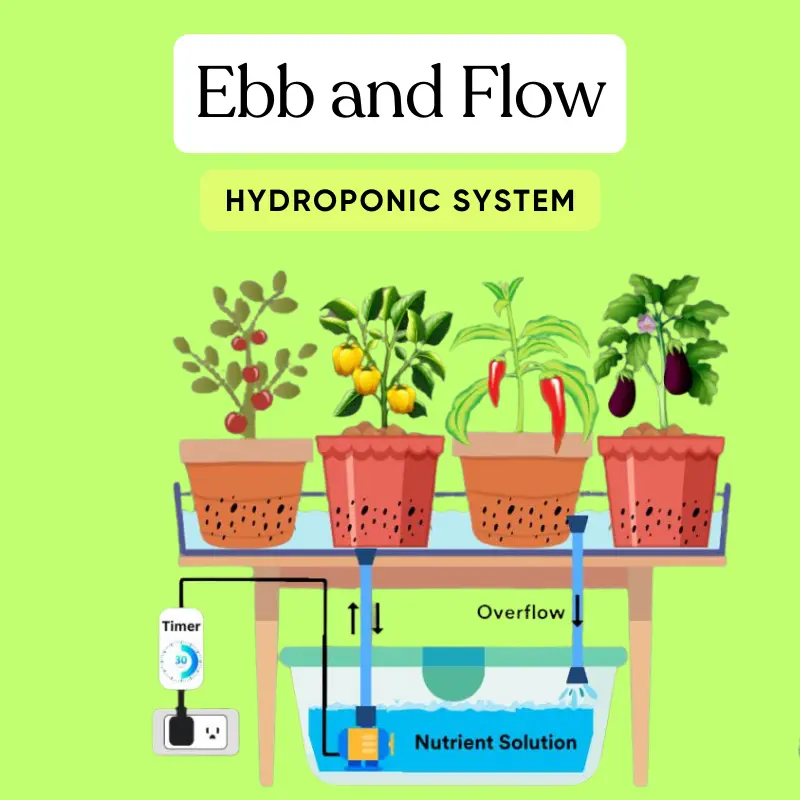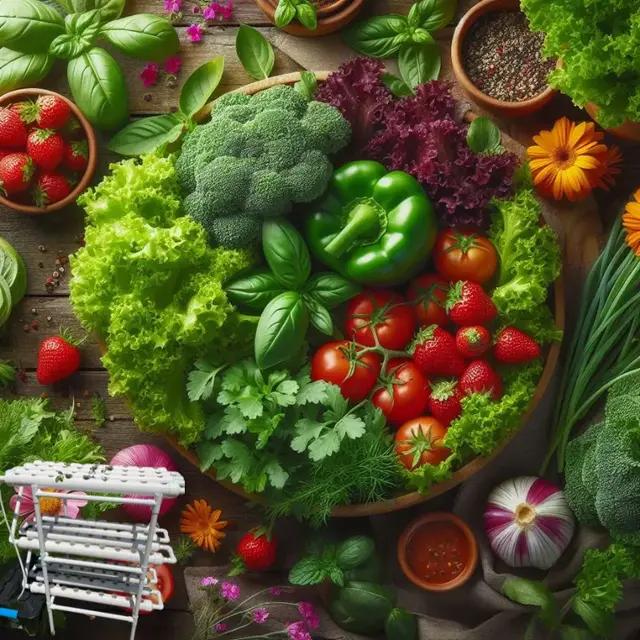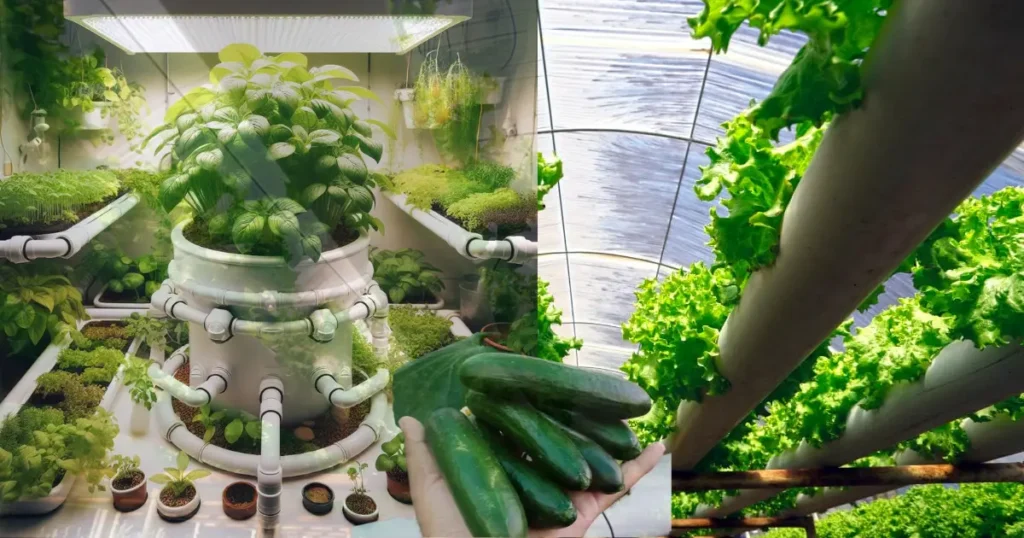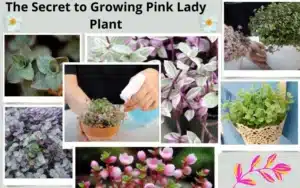Have you ever wondered what it would be like to grow your own produce year-round, without soil ? 🌱
With so many hydroponic systems out there, it can be overwhelming to choose the right one for you. That’s where ebb and flow hydroponics comes in! 🚀
Ebb and flow hydroponics is a type of hydroponic system that works by periodically flooding the growing area with a nutrient-rich water solution and then draining it back into a reservoir. This process is controlled by a pump and a timer, which can be adjusted to meet the specific needs of your plants.
The core principle of ebb and flow hydroponics is to provide the plants with the right amount of oxygen and nutrients at the right time. By flooding the growing area with water, the plant roots are able to take in the necessary nutrients and oxygen. And when the water is drained, the roots are able to take in oxygen from the air.
With its simplicity and efficiency, it’s a great option for growers of all levels. So, are you ready to get started with ebb and flow hydroponics? 🤔💧🌿
- What is ebb and flow hydroponics?
- The advantages of choosing an ebb and flow system for your hydroponic garden
- How to set up your ebb and flow hydroponic system? 🔧
- Maintaining your ebb and flow hydroponics system
- Advanced techniques and customization
- Grower testimonials: Happy plants, Happy growers
- FAQs: Ebb and Flow Hydroponics
What is ebb and flow hydroponics?
If you’re new to the world of hydroponics, you might be wondering what exactly ebb and flow hydroponics is. Well, let me tell you!
An ebb and flow system is a type of hydroponic system that floods and drains the growing area with a nutrient-rich water solution to provide the plants with the right amount of oxygen and nutrients. It’s also known as a flood and drain system, and it’s a popular choice among growers for its simplicity and efficiency.
How Does it Work? 💧
The mechanics of an ebb and flow system are simple. The system consists of a grow tray filled with a growing medium, a reservoir filled with a nutrient-rich water solution, a pump, and a timer.
During the flooding cycle, the pump is activated, and the nutrient-rich water solution is pumped from the reservoir to the grow tray. The water floods the growing area, allowing the plant roots to take in the necessary nutrients and oxygen.
Once the flooding cycle is complete, the pump is turned off, and the water is drained back into the reservoir. This allows the plant roots to take in oxygen from the air.
Key components of an ebb and flow system 🧱
- Grow Tray: A container where the plants are grown and the nutrient-rich water solution is temporarily stored.
- Reservoir: A container where the nutrient-rich water solution is stored and from which the water is pumped.
- Pump: A device that pumps the nutrient-rich water solution from the reservoir to the grow tray.
- Timer: A device that controls when the pump is activated and deactivated.
- Explain the mechanics of the ebb and flow system (flooding and draining cycle).
- Describe the key components of an ebb and flow system (grow tray, reservoir, pump, timer).
- Discuss the role of growing medium in ebb and flow systems (e.g., hydroton, perlite).
- Keywords: Ebb and flow system components, grow tray, reservoir, pump, timer, growing medium, hydroton, perlite
Growing medium 🌱
In an ebb and flow system, a growing medium is used to support the plant roots. Common growing media include hydroton and perlite.
- Hydroton: is a type of clay pellet commonly used in hydroponic systems. It has excellent drainage and aeration properties, making it an ideal growing medium for ebb and flow systems.
- Perlite: is a type of volcanic rock that is crushed and heated to create a lightweight and porous growing medium. It has excellent drainage and aeration properties, making it a great option for ebb and flow systems.
In summary, an ebb and flow system is a type of hydroponic system that floods and drains the growing area with a nutrient-rich water solution to provide the plants with the appropriate amount of oxygen and nutrients. Do you have any experience with ebb and flow systems ❔
The advantages of choosing an ebb and flow system for your hydroponic garden
Are you on the hunt for a hydroponic system that is efficient, automated, and versatile? Look no further than ebb and flow hydroponics!
- Efficient Water Usage 💧: One of the biggest advantages of ebb and flow hydroponics is its water efficiency. By flooding and draining the growing area, the system is able to recirculate the nutrient-rich water solution, reducing water waste and saving you money in the long run.
- Automated Nutrient Delivery 💡: Ebb and flow hydroponics also offers automated nutrient delivery through a pump and timer. This means that you can set the system to deliver the necessary nutrients to your plants at the right time, without the need for constant monitoring.
- Oxygenation of Roots: Another advantage of ebb and flow hydroponics is root oxygenation. By flooding and draining the growing area, the system allows for the roots to take in oxygen from the air, promoting healthy growth and reducing the risk of root rot.
- Versatility for various plant types 🌱: Ebb and flow hydroponics is also a versatile system that can be used to grow a variety of plants. From leafy greens to fruiting plants, this system can accommodate different plant types, making it a great choice for growers of all levels.
- Scalability for different garden sizes 📈: Ebb and flow hydroponics is a scalable system that can be adapted to different garden sizes. Whether you’re growing a few plants or running a large-scale operation, this system can be customized to meet your specific needs.
Well, the ebb and flow growing method offers many benefits, including efficient water usage, automated nutrient delivery, root oxygenation, plant versatility, and scalability.But, once you’ve decided to give ebb and flow hydroponics a try, the next question is: how do you set it up? 🤔
How to set up your ebb and flow hydroponic system? 🔧
Ebb and flow hydroponics is a great way to grow plants without soil. With the right setup guide, you can have your very own system up and running in no time.

- Step 1: Choosing the right components:
- The first step in setting up your ebb and flow system is to choose the right components. This includes a grow tray, a reservoir, a pump, a timer, and a growing medium, such as hydroton or perlite.
- Step 2: Assembling the system:
- Once you have all the necessary components, it’s time to assemble the system. Start by placing the grow tray on top of the reservoir, and then connect the pump and timer to the reservoir.
- Step 3: Selecting and preparing the growing medium:
- Next, you’ll need to select and prepare the growing medium. This involves rinsing the medium to remove any dust or debris, and then placing it in the grow tray.
- Step 4: Filling the reservoir and adding nutrients:
- Once the growing medium is in place, it’s time to fill the reservoir with water and add the nutrient solution. Make sure to follow the instructions on the nutrient solution package, and adjust the pH level 🧪 as needed.
Setting up an ebb and flow system is a simple and straightforward process, and with a step-by-step guide like this, you can have your own soilless garden up and running in no time.
Now that your ebb and flow system is set up, it’s time to choose the right plants to grow. Are you ready to take your gardening skills to the next level?
Choosing the right plants 🌱
While many plants can thrive in hydroponics, some are better suited to ebb and flow systems than others. Ebb and flow systems are great for growing a variety of plants, including leafy greens, herbs, fruiting plants, and flowers. Some suitable plants for ebb and flow systems include:
- Lettuce.
- Spinach.
- Kale.
- Basil.
- Cilantro.
- Strawberries.
- Tomatoes.
- Marigolds.
- Petunias.

Recommendations for beginners and experienced growers
If you’re a beginner in hydroponics, it’s best to start with easy-to-grow plants, like lettuce or herbs. As you gain more experience, you can move on to more advanced plants, such as fruiting plants or flowers.
Considerations for plant spacing and root development
When choosing the right plants for your ebb and flow system, it’s important to consider plant spacing and root development. Plant spacing is important to ensure that each plant has enough room to grow, while root development is important to ensure that the roots have enough space to spread out and take in the nutrient solution.
Choosing the right plants is a crucial step in maintaining your ebb and flow system. Now that you’ve chosen the right plants, it’s time to move on and ensure their continued growth. It is important to know how to maintain your ebb and flow system.
Maintaining your ebb and flow hydroponics system
System maintenance is a crucial aspect of hydroponics, and it is important to monitor and maintain your ebb and flow system to ensure optimal growth for your plants.
Checking water levels and topping up the reservoir:
Water is the lifeblood of hydroponics, so it is important to check and maintain the water levels in your reservoir to ensure your plants get the nutrients they need.
Monitoring pH and EC levels:
pH and EC (electrical conductivity) levels are important indicators of the health of your nutrient solution, so it is crucial to check and adjust them regularly to ensure your plants are getting the right balance of nutrients.
Adjusting nutrient solution:
Adjustments to the nutrient solution are necessary to ensure optimal growth for your plants, so it is important to monitor and adjust the nutrient solution as needed.
Cleaning the system and preventing algae growth:
Cleaning your ebb and flow system and preventing algae growth are important to ensure the health of your plants and the longevity of your system.
Troubleshooting common issues:
Sometimes, problems can arise, and it is important to troubleshoot and address them quickly to ensure the longevity of your system and the health of your plants.
- Pump malfunctions: can occur, and it is important to check and replace the pump if necessary.
- Clogged tubing or emitters: Clogged tubing or emitters can prevent the nutrient solution from reaching your plants, and it is important to clean them regularly to ensure optimal flow.
- Root rot or diseases: Root rot and diseases can be a serious problem in hydroponics, and it is important to monitor and address them quickly to ensure the health of your plants.
Now that you have a solid foundation in maintaining your ebb and flow system, let’s look at some advanced techniques and customization options to enhance your hydroponics experience.
Advanced techniques and customization

If you’re an experienced grower looking to take your hydroponics to the next level, consider advanced techniques and customization options.
Multi-Tier systems:
Multi-tier systems are a great way to maximize your growing space and increase your yield. These systems use multiple levels of grow trays to grow more plants in a smaller area.
Recirculating deep water culture (RDWC) hybrids:
RDWC hybrids are a popular advanced ebb and flow setup that combines the best of both worlds. These systems use a reservoir filled with nutrient-rich water that is continuously pumped to the grow trays.
Automated control systems:
Automated control systems are a great way to simplify and streamline your ebb and flow system. These systems use sensors and controllers to automate tasks such as water top-ups and nutrient adjustments.
Customization:
Customization is a great way to personalize your ebb and flow system to your specific needs and growing style. Consider adding add-ons such as pH and EC monitors or air pumps to enhance your hydroponics experience.
The ebb and flow hydroponics system is great. It’s always helpful to see real-world examples of successful ebb and flow hydroponics systems. That’s why we’ve gathered some case studies and success stories for you to check out. 😀
Grower testimonials: Happy plants, Happy growers
Ebb and flow hydroponics has revolutionized the way growers cultivate their plants. Here are some testimonials from growers who have experienced the benefits of ebb and flow hydroponics:
“With ebb and flow hydroponics, I can grow more plants in less space and with less water! My harvest yields have significantly increased.” – John D., Commercial Grower
“I was initially skeptical, but ebb and flow hydroponics has completely transformed my gardening experience. My plants are thriving, and I have greater control over the growing conditions than ever before.” – Sarah L., Home Grower
“I never thought I could grow fresh greens and herbs year-round in my home. Ebb and flow hydroponics has made it possible, and my family loves the taste and quality of our home-grown produce.” – Mike T., Home Grower
“I started using ebb and flow hydroponics for my commercial operation, and the results have been astounding. My harvest yields have increased by 30%!” – Emily W., Commercial Grower
“As a commercial lettuce grower, ebb and flow has significantly boosted my production. It is an efficient and easy-to-manage system, and the results speak for themselves.” – Mark, Commercial Grower
Let’s wrap up our discussion on ebb and flow hydroponics with some final thoughts and takeaways.
All in all, ebb and flow hydroponics is a powerful growing method that can transform the way growers grow their plants. It offers improved water efficiency and crop consistency, as well as diverse applications and plant varieties. Ebb and flow hydroponics opens up a world of opportunities for growers to explore and enjoy.
We hope this guide has provided you with valuable insight and information on ebb and flow hydroponics, and has inspired you to try it out for yourself. Do you have any questions or thoughts? Share them with us in the comments below!
Thanks for reading and happy growing! 🌱
FAQs: Ebb and Flow Hydroponics
What plants can be grown with ebb and flow hydroponics?
Ebb and flow hydroponics can support a wide range of plant applications and varieties, including leafy greens, herbs, fruiting plants, and flowers.
What equipment is needed for ebb and flow hydroponics?
The basic equipment needed for ebb and flow hydroponics includes a reservoir, nutrient solution, grow tray, pump, timer, and tubing. Additional equipment like air pumps and pH and EC monitors can enhance system performance and provide greater control over growing conditions.
What are the benefits of ebb and flow hydroponics?
Ebb and flow hydroponics offers a variety of benefits compared to traditional soil gardening, including improved water efficiency, faster growth rates, higher yields, more consistent crop quality, and reduced pest and disease pressure.

About the Author
As a woman expert in sustainable, environmental, and natural farming methods.
I write about houseplant care sharing tips and tricks i’ve learned over the years to help keep your plants happy and healthy.



